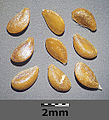Narrow-leaved flax
| Narrow-leaved flax | ||||||||||||
|---|---|---|---|---|---|---|---|---|---|---|---|---|

Narrow-leaved flax ( L. tenuifolium ) |
||||||||||||
| Systematics | ||||||||||||
|
||||||||||||
| Scientific name | ||||||||||||
| Linum tenuifolium | ||||||||||||
| L. |
Narrow-leaf flax ( Linum tenuifolium ), also called narrow- leaf flax , is a species of the genus flax ( Linum ).
description
The narrow-leaved flax is a perennial plant. The root is strong, spindle-shaped and hardly branched, it also forms a strongly branched earth stick. In addition to flower sprouts, sterile sprouts are also formed. It reaches a height of (10) 15 to 45 centimeters. The stems are erect or ascending and are usually in groups. The stalks are lignified at the bottom. They are not very branched. They are hairy short on the base.
The leaves are alternate. They don't have any basal glands. The middle leaves are 10 to 25 (30) millimeters long and 1 to 1.5 millimeters wide and linear. The leaves are single-nerved and have small teeth on the edge. They are flat or slightly curled at the edge.
The flowers have a diameter of up to 22 millimeters. The flower stalks are the same length or slightly shorter than the bracts . The sepals are 5 to 7 (8) millimeters long. Their shape is eilanzettlich, pointed at the end. They are one-nerved, the leaf margin is ciliate and finely toothed. The petals are 10 to 15 millimeters long and free. The color is light purple or whitish. The stamens are 6 to 7 millimeters long. They are hairy at the widened base. The stylus are thin, around 6 millimeters long and have a heady scar . The flowering period is June and July, pollination takes place mainly by insects ( entomophilia ), self-fertilization also occurs.
The fruit stalk is upright. The capsule is almost spherical. It is 2.7 to 3.5 (4) millimeters long and bald. The beak is around 0.7 millimeters long and pointed. The seeds are elongated, narrow and around 2 millimeters long. The surface is smooth and light brown.
The number of chromosomes is 2n = 16 or 18.
distribution
The narrow-leaved flax is native to Central and Southern Europe as far as Asia Minor. In the southwest of Germany it occurs mainly on grasslands, the northernmost occurrence here is in the Leinetal in southern Lower Saxony and on the Moselle .
It grows on dry limestone lawns and in rock steppes. He is a Xerobromion federation character in Central Europe. He prefers dry, lime-rich, loose loam and loess soils, as well as stone and gravel soils. It occurs up to the montane altitude range , in Valais it occurs up to 1500 m.
photos
literature
- Siegmund Seybold (Ed.): Schmeil-Fitschen interactive (CD-Rom), Quelle & Meyer, Wiebelsheim 2001/2002, ISBN 3-494-01327-6
Individual evidence
- ↑ a b Erich Oberdorfer : Plant-sociological excursion flora for Germany and neighboring areas . 8th edition. Verlag Eugen Ulmer, Stuttgart 2001, ISBN 3-8001-3131-5 . Page 631.
Web links
- Narrow-leaved flax. In: FloraWeb.de.
- Profile and distribution map for Bavaria . In: Botanical Information Hub of Bavaria .
- Linum tenuifolium L. In: Info Flora , the national data and information center for Swiss flora . Retrieved November 29, 2015.
- Thomas Meyer: Data sheet with identification key and photos at Flora-de: Flora von Deutschland (old name of the website: Flowers in Swabia )




